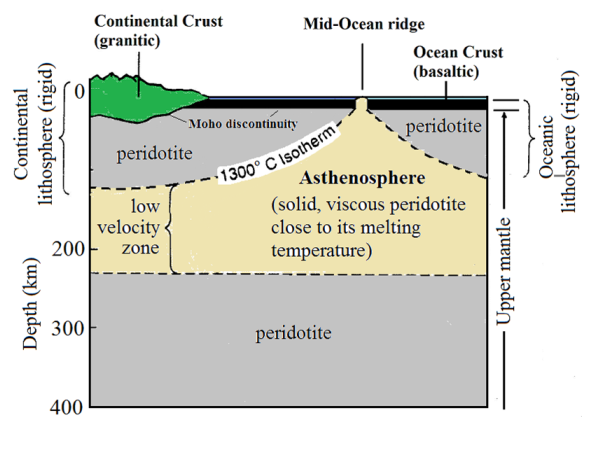Mechanical properties - 'lithosphere' and 'asthenosphere'
We may think we know what we mean by the Earth's 'tectonic plates', but there is more to a tectonic plate than just 'crust'. A clue to this may be found in the other name for 'tectonic plate', which is 'lithospheric plate'.
It is not just the chemistry of rocks that may change with depth - their mechanical properties also change, according to pressure and temperature. Both factors affect rock's mechanical strength, whatever its chemical composition.

Lithospheric plates (continental and oceanic) above the asthenosphere.
Image courtesy of Pete Loader.
As temperatures rise with depth, rocks reach temperatures that would cause them to melt if they were at the surface. The rocks remain solid at depth despite their temperature because of the extreme pressures acting upon them. However, they do become plastic. Subjected to immense forces, and with vast amounts of time, such rocks will flow.
Some substances display this property of solid creep even at the surface. Think, for example, of chocolate, which in a warm room may flow and deform without melting. Substances like plasticine (potty putty) will also flow under gravity, especially when warm. Pitch, used for roads, can be brittle when struck with a hammer, but still flow very slowly, just as ice does when a glacier moves downhill.
The temperature gradient of the Earth means that, at a certain depth in the upper mantle, peridotite will behave like this too. This occurs when peridotite reaches 1300oC and gives rise to a layer called the asthenosphere, where the rock is weaker than both overlying and underlying mantle.
The rocks above the asthenosphere, being the uppermost mantle plus the overlying crust (either continental or oceanic) behave mechanically as one, and comprise what geologists call the 'lithosphere'. The lithosphere moves as one over the weaker, plastic asthenosphere.
So, to a geologist the outermost shell of the Earth is the lithosphere, which is partly made of crust and partly upper mantle (as defined by its composition), but which mechanically moves as a single unit.